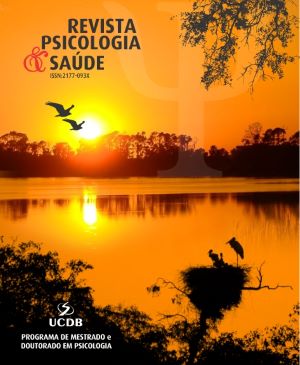The Pfister Test and its Contribution to the Assessment of Children with Cancer
DOI:
https://doi.org/10.20435/pssa.v14i1.1762Keywords:
childhood cancer, psychological evaluation, PfisterAbstract
Introduction: The objective was to raise cognitive and emotional indicators of children with cancer (clinical group [CG]) and compare the results to children without the disease (non-clinical group [NCG]), as childhood cancer changes family functioning. Method: This is a quantitative, comparative, and transversal research. The study counted twenty-seven children, between 7 and 12 years old, who were evaluated with the Pfister model. For data analysis, categorical variables of color frequency indicators, syndromes and the formal aspects of the instrument were used, in addition to the Chi-Square test. Results: The children's cognitive and emotional aspects in the CG do not show statistically significant differences when compared to the NCG, although some findings can be highlighted. Discussion: It was discussed the smallest differences between the two groups, regarding colors, syndromes and the fact that children with cancer have more structured formal aspects. Conclusion: as a suggestion, it is important to consider how long the children have been in treatment.
References
Alves, S. W. E., & Figueiredo, L. da. R. U. (2017). Estratégias de atuação da psicologia diante do câncer infantil: Uma revisão integrativa. Revista da Sociedade Brasileira de Psicologia Hospitalar, 20(1), 55-74. DOI: https://doi.org/10.57167/Rev-SBPH.20.231
Aquino, A. M. de.; Conti, L. de., & Pedrosa, A. (2014). Construções de significados acerca do adoecimento e morte nas narrativas de crianças com câncer. Psychology/Psicologia reflexão e crítica, 27(3), 599-606. http://dx.doi.org/10.1590/1678-7153.201427322 DOI: https://doi.org/10.1590/1678-7153.201427322
Caprini, F. R., & Motta, A. B. (2017). Câncer infantil: Uma análise do impacto do diagnóstico. Revista Psicologia: Teoria e Prática, 19(2), 164-176.
http://dx.doi.org/10.5935/1980-6906/psicologia.v19n2p161-173 DOI: https://doi.org/10.5935/1980-6906/psicologia.v19n2p161-173
Cardoso, L. M., & Capitão, C. G. (2007). Avaliação psicológica de crianças surdas pelo Teste das Pirâmides Coloridas de Pfister. PsicoUSF, 12(2), 135-144. http://dx.doi.org/10.1590/S1413-82712007000200002 DOI: https://doi.org/10.1590/S1413-82712007000200002
Cardoso, L. M., Lopes, E. I. X., Marques, T. M., & Targino, R. M. (2018). Evidence of concurrent validity for the use of the Pfister test from children of Ceará. Psicologia: Teoria e Pesquisa, 20(2), 134-146. http://dx.doi.org/10.5935/1980-6906/psicologia.v20n2p134-146 DOI: https://doi.org/10.5935/1980-6906/psicologia.v20n2p134-146
Cardoso, L. M., Bessa, L. B., & Targino, R. M. (2019). Comparison of the Emotional Indicators of the Pfister Test between Boys and Girls from Ceará-Brazil. Trends in Psychology, 27(1), 1-10. http://dx.doi.org/10.9788/TP2019.1-01 DOI: https://doi.org/10.9788/TP2019.1-01
Castro, E. H. B. de. (2010). A experiência do câncer infantil: Repercussões familiares, pessoais e sociais. Revista Mal Estar e Subjetividade, 10(3), 971-994. http://pepsic.bvsalud.org/scielo.php?script=sci_arttext&pid=S1518-61482010000300013
Carvalho, A. C. (2017). A criança e o câncer: Expressões emocionais envolvidas no processo de adoecimento (Dissertação de Pós-Graduação em Psicologia, Instituto de Psicologia da Universidade de São Paulo, São Paulo). https://teses.usp.br/teses/disponiveis/47/47133/tde-04092017-155404/publico/carvalho_corrigida.pdf
Cohen, R. J., Swerdlik, M. E., & Sturman, E. D. (2014). Testagem e avaliação psicológica: Introdução a testes e medidas (8a ed). AMGH.
Instituto Nacional do Câncer. (2017). Tipos de câncer infantil. INCA. http://www2.inca.gov.br/wps/wcm/connect/tiposdecancer/site/home/infantil
Santos, M. Z., Sarda-Júnior, J. J., Menezes, M., & Thieme, A. L. (2013). Avaliação do desenvolvimento de crianças com câncer por meio do DFH III. Avaliação Psicológica, 12(3), 325-332. http://pepsic.bvsalud.org/scielo.php?script=sci_arttext&pid=S1677-04712013000300007
Silva, A. M., Gallego, E. T., & Teixeira, M. C. T. V. (2006). Habilidades intelectuais de crianças com câncer e crianças não portadoras da doença. Avaliação Psicológica, 5(1), 33-41. http://pepsic.bvsalud.org/scielo.php?script=sci_arttext&pid=S1677-04712006000100005
Van Schoors, M., Caes, L., Knoble, N. B., Goubert, L., Verhofstadt, L. L. & Alderfer, M. A. (2017). Systematic Review: Associations Between Family Functioning and Child Adjustment After Pediatric Cancer Diagnosis – A Meta-Analysis. Journal of Pediatric Psychology, 42(1), 6-18. http://dx.doi.org/10.1093/jpepsy/jsw070/ DOI: https://doi.org/10.1093/jpepsy/jsw070
Villemor-Amaral, A. E. (2005). As pirâmides coloridas de Pfister – Versão para crianças e adolescentes. Casa do Psicólogo.
Villemor-Amaral, A., E. (2013). As pirâmides coloridas de Pfiter. Casa do Psicólogo.
Villemor-Amaral, A. E. (2015). As pirâmides coloridas de Pfister – versão para crianças e adolescentes. In A. E. Villemor-Amaral (Ed.), Análise e Interpretação (pp. 171-207). Casa do Psicólogo.
Villemor-Amaral, A. E., Pardini, P. M., Tavella, R. R., Biasi, F. C., Migoranci, P. B. (2012). Evidências de validade do teste de Pfister para avaliação de crianças. Avaliação Psicológica, 11(3), 423-434. http://pepsic.bvsalud.org/scielo.php?script=sci_arttext&pid=S1677-04712012000300009
Villemor-Amaral, A. E., Tavella, R. R., Cardoso, L. M., Biasi, F. C., & Pavan, P. M. P. (2014). Teste das pirâmides coloridas de Pfister e a criatividade em crianças. Revista Psicologia: Teoria e Prática, 16(3), 114-124. http://pepsic.bvsalud.org/scielo.php?script=sci_arttext&pid=S1516-36872014000300009 DOI: https://doi.org/10.15348/1980-6906/psicologia.v16n3p114-124
Published
How to Cite
Issue
Section
License
The articles published on journal Psicologia e Saúde holds the copyrights of all texts published by it. Due to that, there is a demand for a letter of copyright cession (see Appreciation). The full reproduction of any article of this Journal in other publications, by any means, requires a written authorization of the Editorial Board. Partial reproductions of articles (abstracts, more than 500 words of text, tables, pictures and other illustrations, sound files) should have the written permission of the Editorial Board and the Authors.












